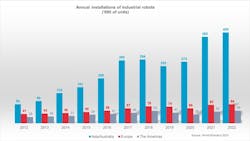Worldwide Industrial Robot Installations Climb; Up in 2022
Factories around the world installed a total of 553,052 new industrial robots in 2022—a 5% growth rate, compared with 2021, according to a new report from the International Federation of Robotics (Frankfurt, Germany), a trade association.
In 2023, the federation expects the growth rate to reach 7% worldwide, or more than 590,000 new units.
Collaborative robots, or cobots, which work around people, represent a small but growing share of industrial robots, according to the federation. In 2017, for example, manufacturers added 11,000 cobots (about 2% of the total) and 389,000 traditional robots. In 2022, however, they added 55,000 cobots (about 10% of the total) and 498,000 traditional robots.
China is the largest market for industrial robots. The country installed 290,258 units in 2022, a 5% growth rate compared to 2021.
Meanwhile in 2022, Japan installed 50,413 units, up 9%, and the Republic of Korea installed 31,716 units, up 1%.
The European Union installed 70,781 units, up 5%.
In the Americas, factories installed 56,053 units in 2022, up 8%. In the United States, robot installations were up by 10% to 39,576 units. This was just shy of the peak level of 40,373 units achieved in 2018. “On a global scale, the United States accounted for 7% of robot installations in 2022, placing the US third in the world following China and Japan,” explains Marina Bill, president of the International Federation of Robotics. However, new orders of robots were down in the first two quarters of 2023 in the United States, the federation says.
Overall, the federation expects the number of installations installations to grow worldwide. “There is no indication that the overall long-term growth trend will come to an end soon; rather the contrary will be the case. The mark of 600,000 units installed per year worldwide is expected to be reached in 2024,” it said in a news release.
There are a total of 3.9 million robots operating in factories worldwide, with 30% in the automotive industry and 26% in electronics, according to the federation.
